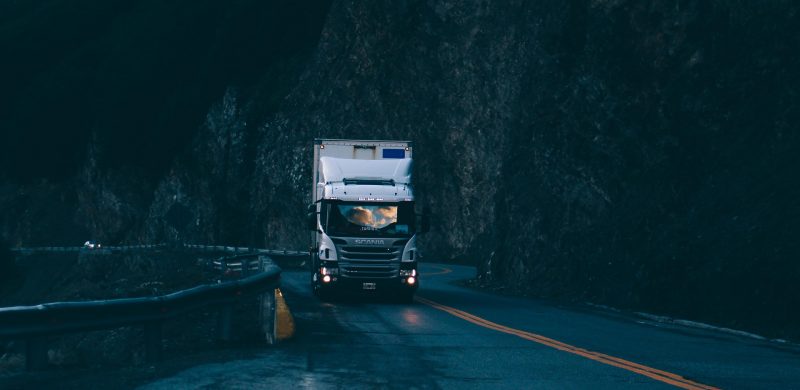
There have been many advances in the transport sector. Most of them have been in trailer technology or in the fuel saving abilities of the engine. Based in California, Peloton Technologies, an automated vehicle technology company solving truck crashes and fuel use challenges faced by the trucking industry. The company is pioneering the use of V2V (vehicle to vehicle communication). Using radar sensors, intelligent braking, video screens, and a wireless link, Peloton makes it possible for two trucks to connect in a “platoon,” or “closer together than would normally be safe.
The two trucks are able to get as close as 20 feet from each other while platooning in order to take advantage of fuel-saving aerodynamics. Peloton reports fuel savings of 10% for the second truck and 4.5% for the lead truck in a platoon. The trucks are able to get this close thanks to Peloton’s active safety system which wirelessly links the trucks. The wireless link controls the truck’s acceleration and braking, while radar detects potential dangers up ahead. The linked trucks react within a “fraction of a second” whereas a truck driver needs up to two seconds to react to changes in conditions. While the wireless link controls acceleration and braking, drivers still have complete control of the truck. Even while trucks aren’t platooning, Peloton is making trucking safer with the use of video screens in cabs to monitor blind spots.
Peloton is also currently developing a network operations centre which can coordinate trucks that are from different fleets. The network operations centre will also collect data on driver fatigue and vehicle maintenance.
Software applications are also shaking up the transportation technology industry. A new product in the trucking industry, KeepTruckin, is a mobile app logbook designed to let truck drivers “quickly and easily enter their hours on their smartphone.” In the past, truckers had to record their hours on paper logs, then either mail or fax them to dispatchers. As the rules for Hours of Service became more complex, drivers and fleet managers needed a new way to manage their logs. The app will automatically let drivers know if they are in danger of Hours of Service Violations, helping fleets improve their CSA scores. Also, the app allows for fleet tracking and load status monitoring for dispatchers to effectively stay on top of their fleet’s whereabouts.
In the spirit of collaborating, Walmart has created a new concept truck – the Walmart Advanced Vehicle Experience (WAVE) with Peterbilt, Capstone Turbine, and Great Dane Trailer
In the spirit of collaborating, Walmart has created a new concept truck – the Walmart Advanced Vehicle Experience (WAVE) with Peterbilt, Capstone Turbine, and Great Dane Trailer.
The Walmart Advanced Vehicle Experience concept truck – the result of a partnership between many vendors – is the latest in our fleet efficiency program. This prototype combines aerodynamics, mictroturbine-hybrid powertrain, electrification, advanced control systems, and cutting edge materials like carbon fiber all in one vehicle. We’re more than 84% of the way to our goal, and bold innovations like this will take us the rest of the way.
Walmart Advanced Vehicle Experience Key Components
| Tractor | Trailer |
| Advanced aerodynamics (20% aero improvement from current Model 386) | Trailer body built almost exclusively with carbon fiber; single-piece 53-foot panels in roof and sidewalls |
| Microturbine-powered series hybrid electric drivetrain is clean, efficient and fuel flexible | Use of advanced adhesives eliminates need for most rivets |
| Centered driver’s seat that can rotate 180 degrees | Convex nose shape enhances aerodynamics while maintaining cargo capacity |
| Electronic dashboard with customizable gauges and performance data | Solid, 53-foot one-piece floor reduces weight without sacrificing strength or performance |
| Sliding driver’s door and fold out step for safety and security | Next-generation low-profile LED lighting is more energy efficient and less prone to damage |
| Full size cab/sleeper Flex Studio with fold out bed |
While the Walmart Advanced Vehicle Experience is still a prototype, Walmart is not only attempting to improve its own fleet efficiency, but also advance the future of the entire trucking industry with this application transportation technology.
Unlike other folding containers that collapse horizontally, the New Jersey-based Staxxon design folds concertina-style from right to left in the vertical position, allowing up to five folded units to be interconnected and handled as a single ISO-sized module for empty repositioning purposes.
The Staxxon 20ft design was approved for a maximum gross weight of 24,000 kg with a maximum load of 20,824 kg. Stacking ratings are 86,400 kg on the corner post and 192,000 kg in total at up to eight high. Floor strength is rated at 7,257 kg and gross interior capacity is 32.536 m3.
Staxxon brings a fresh perspective to an old problem in the logistics industry. For decades, empty cargo containers have led to inefficiencies at ports. Staxxon hopes to bring a sustainable alternative to normal, rigid cargo containers by producing vertically folding, retrofitted containers. Staxxon’s goal is to “reduce the number of container ship movements as well as intra-state truck movements at ports related to empty containers.” These foldable containers will reduce the “cost and inefficiencies involved in moving empty intermodal containers.”
Staxxon folds containers vertically by collapsing the doors of the container and pushing the outer walls of the container in towards each other. With this method, five empty, collapsed containers can fit into the same space as one normal, non-folding container. Retrofitting old containers to be collapsable rather than designing and building completely new containers is another hallmark of Staxxon’s sustainable business model.
Clearly, many companies are determined to bring fresh ideas to the transportation industry’s challenges. As these pioneering companies succeed, even more companies will follow, using transportation technology to advance the transportation industry.
@nelson.madzima





